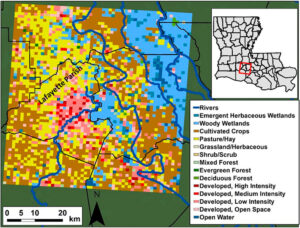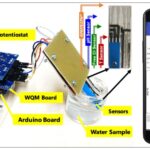Creating soil moisture prediction models using the Short-Term Memory (LSTM) machine learning algorithm has several practical applications, including:
Precision agriculture: Accurate soil moisture prediction can help farmers make informed decisions regarding irrigation scheduling, fertilization, and crop selection. This can lead to improved crop yields, reduced water and fertilizer usage, and increased profitability.
Water resource management: Soil moisture prediction can also be used to manage water resources in agricultural areas, particularly in regions where water is scarce or subject to regulations. Accurate soil moisture prediction can help allocate water resources more efficiently and sustainably.
Climate monitoring and forecasting: Soil moisture is an important parameter in climate models and can be used to monitor and forecast droughts, floods, and other extreme weather events. Accurate soil moisture prediction can improve the accuracy of climate models and enable better decision-making for disaster management.
How to get started?
You could follow these steps:
- Conduct a literature review: Start by searching for relevant research papers, academic journals, and other sources related to soil moisture prediction models and the use of the LSTM machine learning algorithm. This will give you a comprehensive understanding of the current state of research in this field.
- Identify the data sources: Determine the data sources required for developing soil moisture prediction models using the LSTM algorithm. This could include data related to soil properties, weather patterns, land use, and other factors that influence soil moisture levels.
- Data preparation: Gather, preprocess and clean the data, such as removing missing values, handling outliers, and performing feature engineering to prepare the data for modeling.
- Select LSTM model: Choose the most suitable LSTM model architecture for the soil moisture prediction task. There are various types of LSTM models, such as univariate, multivariate, and time series, so select the appropriate one based on the problem requirements.
- Train the model: Split the data into training and validation sets, train the LSTM model, and evaluate its performance.
- Tune hyperparameters: Fine-tune the hyperparameters of the LSTM model to optimize its performance, such as the number of layers, learning rate, batch size, and activation functions.
- Validate the model: Validate the performance of the LSTM model using metrics such as accuracy, root mean square error, and coefficient of determination.
- Compare with other models: Compare the performance of the LSTM model with other machine learning algorithms commonly used for soil moisture prediction, such as Random Forest, Support Vector Machines, and Artificial Neural Networks.
- Conclusion and future work: Summarize the findings and suggest potential avenues for future research to improve soil moisture prediction models using the LSTM algorithm.
Which works can I refer to?
There has been significant research on using the LSTM machine learning algorithm for creating soil moisture prediction models. Here are some examples of the work that has been done in this area:
- “A Deep Learning Framework for Soil Moisture Prediction Using Long Short-Term Memory (LSTM) Networks” by Liu et al. (2020): In this study, the authors used a deep learning framework based on LSTM networks to predict soil moisture in the root zone. They found that the LSTM model outperformed traditional machine learning algorithms such as support vector regression and random forests.
- “Deep Learning for Soil Moisture Retrieval Using Sentinel-1 SAR Data” by Piles et al. (2019): This study used LSTM networks to retrieve soil moisture from Sentinel-1 synthetic aperture radar (SAR) data. The authors found that LSTM networks performed better than other machine learning algorithms and could accurately predict soil moisture under different weather and land-use conditions.
- “Soil Moisture Prediction Using Long Short-Term Memory Networks and Multisource Data Fusion” by Li et al. (2021): In this study, the authors proposed a soil moisture prediction model based on LSTM networks and multisource data fusion. The model combined remote sensing data, meteorological data, and soil properties to predict soil moisture with high accuracy.
- “Soil Moisture Prediction with Machine Learning Using Sentinel-1 and -2 Satellite Data” by Araya et al. (2021): This study used machine learning algorithms, including LSTM networks, to predict soil moisture using Sentinel-1 and -2 satellite data. The authors found that LSTM networks performed better than other machine learning algorithms and were effective in predicting soil moisture under different weather conditions.

Despite the progress that has been made in using the LSTM machine learning algorithm for creating soil moisture prediction models, there are still several research gaps that need to be addressed. Here are some of the research gaps in this area:
Lack of standardized protocols: There is a lack of standardized protocols for data collection, preprocessing, and model evaluation, which makes it challenging to compare the results of different studies. Standardized protocols could improve the reproducibility and generalizability of soil moisture prediction models.
Limited data availability: The availability of high-quality data is crucial for developing accurate soil moisture prediction models. However, there is a shortage of ground-based data, which limits the ability to train and validate models. Researchers need to explore new data sources or develop methods for augmenting existing data.
Limited interpretability: One of the challenges of using deep learning models, such as LSTM networks, is their limited interpretability. It is difficult to understand how the models arrive at their predictions and identify which features are most important. Interpretable models could improve the trustworthiness and usability of soil moisture prediction models.
Limited spatial resolution: Current soil moisture prediction models based on remote sensing data have limited spatial resolution, which can affect their accuracy. Researchers need to explore new techniques, such as data fusion or downscaling, to improve the spatial resolution of soil moisture prediction models.
Limited application to different soil types and climates: Most of the research on soil moisture prediction models using LSTM networks has been conducted in specific regions or with specific soil types. Further research is needed to evaluate the performance of these models in different climates and soil types to improve their generalizability.
Datsets to Explore?

Several types of datasets can be used for creating soil moisture prediction models using the LSTM machine learning algorithm. Here are some examples:
Remote sensing data: Remote sensing data, such as data from satellites or airborne sensors, can be used to estimate soil moisture. Some examples of remote sensing data sources include Synthetic Aperture Radar (SAR) data, microwave radiometry data, and optical remote sensing data.
Meteorological data: Meteorological data, such as precipitation, temperature, and humidity, can be used to estimate soil moisture. These data can be obtained from weather stations or from reanalysis products that provide global meteorological data.
Soil properties data: Soil properties data, such as soil texture, bulk density, and organic matter content, can be used to estimate soil moisture. These data can be obtained from soil surveys or laboratory analyses.
Ground-based soil moisture data: Ground-based soil moisture data can be used to train and validate soil moisture prediction models. These data can be obtained from soil moisture sensors, such as time domain reflectometry (TDR) sensors or capacitance sensors.
Land cover and land use data: Land cover and land use data, such as vegetation cover or urbanization, can be used to estimate soil moisture. These data can be obtained from remote sensing data or land cover/land use maps.
There are several datasets available for creating soil moisture prediction models using the LSTM machine learning algorithm. Here are some examples:
NASA Soil Moisture Active Passive (SMAP) mission data: The SMAP mission provides high-quality soil moisture data at a spatial resolution of 9 km. These data are available for download from the NASA Earthdata website.
European Space Agency (ESA) Soil Moisture and Ocean Salinity (SMOS) mission data: The SMOS mission provides global soil moisture data at a spatial resolution of 25 km. These data are available for download from the ESA SMOS mission website.
Global Land Data Assimilation System (GLDAS) data: The GLDAS provides a suite of land surface data, including soil moisture, at a spatial resolution of 0.25 degrees. These data are available for download from the NASA Goddard Earth Sciences Data and Information Services Center.
National Oceanic and Atmospheric Administration (NOAA) Climate Prediction Center (CPC) Unified Gauge-Based Analysis of Global Daily Precipitation data: The CPC Unified Gauge-Based Analysis provides global precipitation data at a spatial resolution of 0.5 degrees. These data are available for download from the NOAA CPC website.
United States Department of Agriculture (USDA) Soil Survey Geographic (SSURGO) database: The SSURGO database provides detailed soil survey information, including soil texture and organic matter content, for the United States. These data are available for download from the USDA Natural Resources Conservation Service website.
What is LSTM?

LSTM stands for Long Short-Term Memory, which is a type of recurrent neural network (RNN) architecture used in deep learning. It is designed to overcome the vanishing gradient problem that arises in traditional RNNs, where the gradients that flow backward through time can become very small or even zero, making it difficult to train the network effectively.
In an LSTM network, the recurrent connections are replaced with memory cells that can remember information over long time periods. These memory cells are controlled by three gates: the input gate, the forget gate, and the output gate. The input gate controls how much new information is allowed into the memory cell, the forget gate controls how much old information is removed from the memory cell, and the output gate controls how much information is passed on to the next layer of the network.
The LSTM architecture is well-suited for processing sequential data, such as time series data, where there are dependencies between observations over time. It has been used successfully in various applications, such as speech recognition, natural language processing, and image captioning, and is also commonly used in environmental and hydrological modeling, including soil moisture prediction.
Try this code for implementing LSTM:
import tensorflow as tf
import numpy as np
import pandas as pd
# Load data
data = pd.read_csv(‘soil_moisture_data.csv’)
# Split into input (X) and output (y) variables
X = data.iloc[:, :-1].values y = data.iloc[:, –1].values
# Normalize input data
from sklearn.preprocessing import StandardScaler
scaler = StandardScaler() X = scaler.fit_transform(X)
# Split into training and test sets from sklearn.model_selection import train_test_split
X_train, X_test, y_train, y_test = train_test_split(X, y, test_size=0.2, random_state=42)
# Reshape input data to 3D for LSTM
X_train = X_train.reshape((X_train.shape[0], 1, X_train.shape[1]))
X_test = X_test.reshape((X_test.shape[0], 1, X_test.shape[1]))
# Define LSTM model
model = tf.keras.Sequential()
model.add(tf.keras.layers.LSTM(50, activation=‘relu’, input_shape=(1, X_train.shape[2])))
model.add(tf.keras.layers.Dense(1))
model.compile(optimizer=‘adam’, loss=‘mse’)
# Train LSTM model
history = model.fit(X_train, y_train, epochs=100, batch_size=32, validation_data=(X_test, y_test), verbose=2)
# Evaluate LSTM model
mse, _ = model.evaluate(X_test, y_test, verbose=0)
print(‘Mean Squared Error:’, mse)
# Make predictions using LSTM model
y_pred = model.predict(X_test)
Implementing an LSTM involves several steps, including data preprocessing, model architecture design, training, and evaluation. Here is a general overview of the steps involved:
Data preprocessing: The first step is to preprocess the input data, which may include cleaning, normalization, and feature extraction. For soil moisture prediction, this may involve obtaining soil moisture measurements from various sources (e.g., satellite data, soil sensors), selecting relevant meteorological variables (e.g., temperature, precipitation), and transforming the data into a suitable format for the LSTM.
Model architecture design: The next step is to design the LSTM architecture, which may involve selecting the number of memory cells, the number of layers, the activation functions, and the type of regularization. In soil moisture prediction, the input data may be fed into the LSTM network in a sequence, with the output being the predicted soil moisture values.
Training: Once the model architecture is defined, the LSTM is trained using a labeled dataset. This involves feeding the input data into the network and adjusting the weights and biases of the network using an optimization algorithm, such as stochastic gradient descent (SGD). The training process is repeated for a certain number of epochs or until a certain convergence criterion is met.
Evaluation: After training, the performance of the LSTM model is evaluated using a validation dataset that was not used during training. This may involve computing various metrics, such as root mean square error (RMSE), mean absolute error (MAE), and correlation coefficient (r), to assess the accuracy of the predicted soil moisture values.



